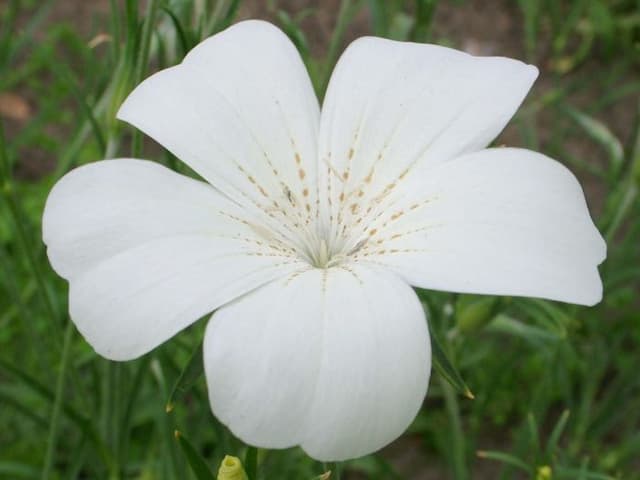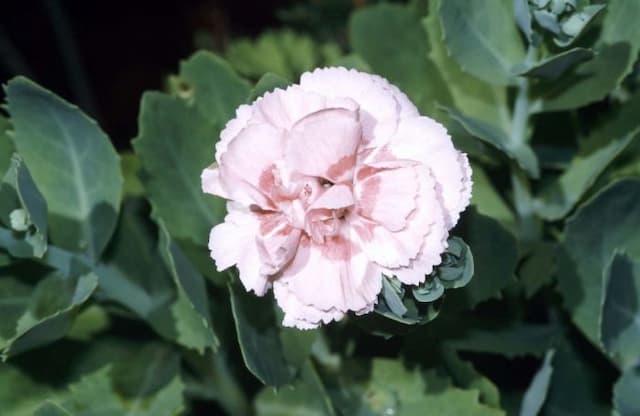Sweet William Dianthus 'Ruth White' (b)

ABOUT
Dianthus 'Ruth White', commonly known as Sweet William, is a visually striking plant known for its distinctive flowers and foliage. The blooms of this plant are typically pure white, giving it a delicate and elegant appearance. Each flower is composed of a frilled or serrated edge, adding a touch of texture and depth to the overall aesthetic. The petals are often densely clustered together to form a bouquet-like shape, presenting a lush and full look. The flowers exude a sweet, clove-like fragrance that is quite appealing and contributes to its popularity in gardens and as a cut flower. The foliage of the Sweet William is slender and tends to be a grayish-green to blue-green color. The leaves are lance-shaped, with a smooth or slightly roughened texture. They form a neat, compact mound that serves as the backdrop for the contrasting white flowers. Overall, the plant presents as a cohesive and tidy mounding form, making it an attractive addition to borders, garden beds, and containers, where its sweet scent can be easily enjoyed.
About this plant
 Names
NamesFamily
Caryophyllaceae.
Synonyms
Carnation, Pinks, Sweet William.
Common names
Dianthus 'Ruth White'
 Toxicity
ToxicityTo humans
The Dianthus 'Ruth White', commonly known as Carnation, is not considered toxic to humans. Generally, if carnations are ingested, they are not known to cause serious harm or severe symptoms of poisoning. However, consuming any plant in large quantities can cause gastrointestinal discomfort, so it is advisable to avoid ingestion.
To pets
Carnation, the most common name of Dianthus 'Ruth White', is typically considered non-toxic to pets. It is not known to cause serious poisoning in animals. However, if a pet consumes a large amount of any plant, including carnations, it might experience mild gastrointestinal upset. Symptoms could include vomiting or diarrhea, but serious complications from ingesting carnations are not commonly reported.
 Characteristics
CharacteristicsLife cycle
Perennials
Foliage type
Evergreen
Color of leaves
Green
Flower color
White
Height
1 foot (30 cm)
Spread
1 foot (30 cm)
Plant type
Herb
Hardiness zones
Varies
Native area
Europe
Benefits
 General Benefits
General Benefits- Aesthetic Appeal: Adds vibrant color and intricate textures to gardens with its white flowers and distinctive pattern.
- Fragrance: The flowers emit a pleasant scent that can enhance the sensory experience of a garden.
- Attracts Pollinators: Dianthus is known to attract bees, butterflies, and other beneficial insects, supporting biodiversity.
- Low Maintenance: Once established, it requires minimal care, making it suitable for busy gardeners or those with limited time.
- Drought Tolerance: It can withstand dry conditions once established, reducing the need for frequent watering.
- Long Blooming Season: Provides a long period of bloom typically throughout the summer, offering prolonged garden interest.
- Compact Growth: Suitable for borders, containers, and small spaces due to its compact size and growth habit.
- Cold Hardy: This plant is capable of surviving in cooler temperatures, thus extending the range of climates where it can be grown.
- Deer Resistance: Often resistant to deer, which can be advantageous in areas where deer predation is a problem.
 Medical Properties
Medical PropertiesThis plant is not used for medical purposes.
 Air-purifying Qualities
Air-purifying QualitiesThis plant is not specifically known for air purifying qualities.
 Other Uses
Other Uses- Dianthus 'Ruth White' petals can be candied and used as edible decorations for cakes and desserts, providing a subtle flavor and a touch of elegance.
- The flowers can be infused to create a naturally scented vinegar that can be used in salad dressings or as a skin toner.
- The strong scent of the flowers can be used in potpourris, adding a touch of natural fragrance to linen closets and drawers.
- Pressed Dianthus flowers can be used in crafting, such as making bookmarks, greeting cards, or framed botanical art.
- The blooms are sometimes used in bath bombs and salts, giving a soothing floral scent to bathwater.
- Floral water made from Dianthus 'Ruth White' can be used as a linen spray for a light, pleasant aroma on bed sheets and curtains.
- Dianthus petals can be incorporated into handmade paper, providing texture and visual interest to the finished product.
- The flower heads can be used in the creation of natural dyes, potentially imparting gentle colors to textiles.
- Dianthus blossoms can be used as a garnish in cocktails, adding a splash of color and a hint of floral taste to beverages.
- These flowers can be included in sachets with other herbs to naturally repel moths and freshen up closets.
Interesting Facts
 Feng Shui
Feng ShuiThe Carnation is not specifically used in Feng Shui practice.
 Zodiac Sign Compitability
Zodiac Sign CompitabilityThe Carnation is not used in astrology practice.
 Plant Symbolism
Plant Symbolism- Love and Admiration: Dianthus flowers are traditionally associated with feelings of love. The name "Dianthus" itself comes from Greek, meaning "flower of the gods," which suggests divine affection. The 'Ruth White' variety, with its pure white petals, can symbolize a particularly sincere and platonic love.
- Boldness: Many Dianthus species are known for their striking and vivid colors. 'Ruth White', while more subtle in hue, still carries the symbolic meaning of boldness and standing out from the crowd, as it makes a distinct impression in any garden.
- Purity and Innocence: The color white has long been associated with purity and innocence, and the 'Ruth White' carnation is no exception. It is often used in bridal bouquets and decor to emphasize these qualities on a wedding day.
 Water
WaterSweet William should be watered deeply once a week, providing about one inch of water each time. Always check the soil moisture before watering; the soil should be slightly dry at the top. In particularly hot or dry weather, you may need to water more frequently, ensuring the plant receives a total of approximately one to two gallons per week. Water at the base of the plant to keep the foliage dry and reduce the risk of disease. During the winter months or in cooler climates, reduce watering to match the plant's slower growth and reduced needs.
 Light
LightSweet William thrives in full sun conditions, requiring at least six to eight hours of direct sunlight daily. The best spot for this plant is in an area where it receives morning sunlight and some afternoon shade, particularly in hotter climates. Ensure the plant is positioned to avoid too much intense, late afternoon sun, which can sometimes be too harsh and may stress the plant.
 Temperature
TemperatureSweet William prefers temperate climates and will do well in temperatures between 40 and 85 degrees Fahrenheit. This plant can tolerate cold down to roughly 20 degrees Fahrenheit but may be damaged by severe frost. The ideal growing conditions for Sweet William are days with moderate temperatures and cool nights, which help enhance the plant's growth and flowering.
 Pruning
PruningPruning Sweet William is essential to promote bushier growth and more abundant blooms. Trim back the spent flowers to encourage a second bloom, and at the end of the blooming season, cut back the stems to maintain a tidy form. Pruning should be done as needed throughout the growing season. Late winter or early spring, before new growth starts, is the best time for a more significant pruning to shape the plant and ready it for the growing season.
 Cleaning
CleaningAs needed
 Soil
SoilSweet William prefers well-draining soil with plenty of organic matter and a pH ranging from 6.0 to 7.5. A mix of two-thirds garden soil and one-third compost or well-rotted manure, with a handful of sand or perlite to improve drainage, works well.
 Repotting
RepottingSweet William doesn't require frequent repotting and can typically be repotted every 2-3 years, as the plant prefers not to be disturbed.
 Humidity & Misting
Humidity & MistingSweet William thrives in average garden humidity conditions and does not require any special humidity considerations.
 Suitable locations
Suitable locationsIndoor
Place Sweet William near a sunny window; water when topsoil is dry.
Outdoor
Plant Sweet William in sun to part-shade; amend soil for drainage.
Hardiness zone
3-9 USDA
 Life cycle
Life cycleThe life of 'Ruth White' Carnation (Dianthus 'Ruth White') begins with seed germination, which requires well-drained soil and light for optimal growth. After germination, the seedling stage involves the establishment of a root system and the sprouting of the first true leaves. During the vegetative stage, the plant develops a robust foliage and stem structure, preparing for flowering. The flowering stage is marked by the blooming of fragrant white flowers, which will attract pollinators for reproduction. After pollination, the plant may produce seeds, which will spread to create new plants, continuing the cycle. Eventually, the plant will enter a period of dormancy or senescence, especially in regions with cold winters, concluding its life cycle.
 Propogation
PropogationPropogation time
Spring-Early Summer
The Dianthus 'Ruth White', also known as Pinks or Sweet William, is typically propagated through stem cuttings. This method is most popular because it is straightforward and generally results in true-to-parent plants. To propagate Dianthus 'Ruth White' by cuttings, a gardener would take a healthy, non-flowering stem from the plant during the late spring or early summer when the plant's growth is most vigorous. The cutting should be about 3-4 inches long, and all the lower leaves should be removed. The cut end is then dipped in rooting hormone to encourage root growth and planted in a well-draining soil mixture. It is essential to keep the soil moist but not soggy to prevent rot. With proper care, the cutting should develop roots within a few weeks and can then be transplanted to a permanent location.








![Pink [Bubblegum]](/_next/image?url=https%3A%2F%2Fplants-admin.emdemapps.com%2Fimages%2Fplants%2F%2Fimages%2F604b596f31cbb.png&w=640&q=75)
